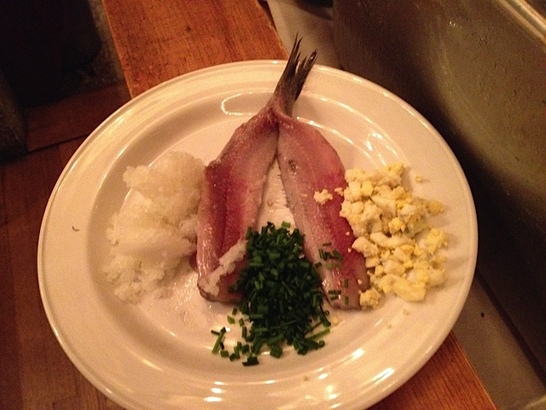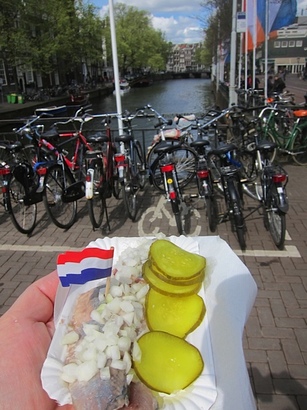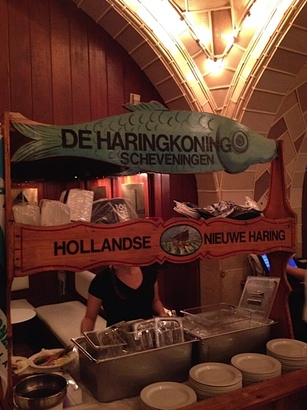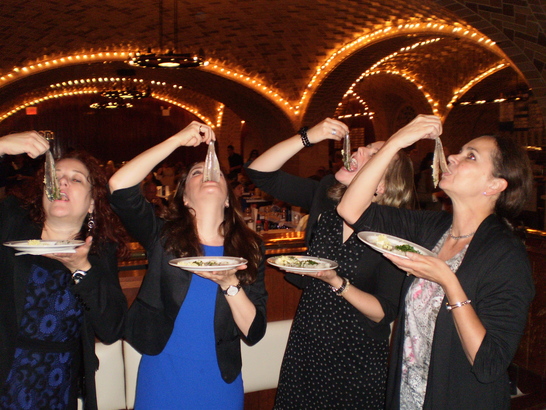The last two weeks of June are holy, holy, holy to herring-lovers world-wide; it is the annual harvest time, as designated by the Dutch authorities, of the "new herring" in Europe's North Sea. But you don't have to go to Amsterdam to enjoy these delectable swimmers (though that's never a bad idea); you only have to go to New York City's Grand Central Oyster Bar before the month is out to sample the fresh catch.

A plate of the "new herring," with eggs, onions and parsley, at the Grand Central Oyster Bar's New Herring Festival
More on this venue later. But first, a burning question:
Why does this herring headline likely leave you indifferent?
I know why. Because...as for most Americans...Dutch "green" herring in June ain't on your bucket list! Oh no. In fact, the thought of herring in any form may make you think of another kind of bucket.
What's the problem here? Europe is obsessed by herring in all forms...but most of us Yanks have never caught the fever.
Sandy Ingber, executive chef of the Grand Central Oyster Bar in New York for 25 years--perhaps the single New York restaurant that sells the most kinds of fish--has often observed "the herring stigma." Diners view herring as hopelessly "old-world, old-times," he says. They think of it as "strong, oily fish, choked with cream or wine sauces." Ingber says that all those prejudices apply until his American customers taste the herring: "then they go wild."
In a sushi-obsessed country such as ours, there is no reason that this delectable New Herring--"the sashimi of the North," I call it--should not be highly popular.
Ah...but getting to this form of herring...even understanding this form of herring...is infernally difficult. One of the reasons that herring doesn't draw much American enthusiasm is that the field is dauntingly complicated, with lots of scary categories, mushy definitions, and sometimes contradictory names. Science can't even narrow herring down to one genus.
But the genus that draws the most attention is clupea harengus, also known as the Atlantic Herring. Unfortunately, within this family...there are nearly 200 different species! And there are subtle differences among them. But, saving grace...they all have silvery skin, a single dorsal fin, and don't grow to be very large. My first piece of advice to the herring neophyte: don't get hung up on the classifications.
It's more important to pay attention to the way in which the herring are treated, after being caught. The "new herring" attract so much excitement because they are the freshest, most unadulterated of herrings. But there are many more herring preps in the world that involve longer, more elaborate methods.
Pickled herring, for example, is probably the most famous group of preparations; it is a favorite throughout northern Europe, and a mainstay of Jewish cuisine. Typically, the herring is salted, drained, then mixed with a sweet-sour solution that contains flavoring ingredients (dill, peppercorns, bay leaves, etc.) Americans sometimes taste mushy versions of pickled herring and are turned off--but the good ones I've had in Scandinavia feature fish that is deliciously resilient. Please don't judge herring by the jars of pickled herring at the supermarket! When a ton of cream is added to an already soft product--the result is not particularly pleasing to most palates.
A better method, arguably, for maintaining the distinction of the fish, is smoking the herring. The Danes and the Swedes are keen on smoked herring...but it is Britain that has the greatest reputation. I love English kippers, which are whole herrings that have been cold-smoked, preserving the delicacy of the fish. You can also get hot-smoked herrings from the British Isles, which are traditionally known as bucklers.
In other cultures, there's dried herring (popular in Asia), fermented herring, fried herring, and herring soup. In many of these preps, the herring are transformed so fundamentally that it's almost absurd to speak of "herring" as if it's one thing.
But true herring-lovers are usually transfixed by herring preparations that have the lightest cures, which enable the true nature of the herring to shine forth. Here's a herring bite I had on the streets of Amsterdam in April, a few years back--more cured than the "new herring" that was soon to come, but still a piece of herring that was very much "about the herring":
And this is why the "new herring" attracts so much attention--the salting cure is so light, just a couple of days, that you can really appreciate the fish itself.
One of the factors is the relative youth of these "new" herrings. They ain't babies, of course; they are usually three years old when harvested in June. But the canny Dutch like to wait that long because, by three years old, the fish have had a chance to reproduce. AND...the production of eggs and milt makes for a fattier, tastier fish.
In fact, "new herring" is one of the world's great examples of perfect timing, understood by practitioners after centuries of trials. Herring are harvested year-round in the North Sea--and the older they get, the further into fall and winter, the fishier they get, with a need for stronger cures. The "June miracle" of new herring is that they now have plenty of fat for gastronomic enjoyment--but the fat has a "fresher," much less fishy taste than the fat in the herrings of winter. Hence the quick, simple salting...and hence the mania.
At the Grand Central Oyster Bar in New York City, you'll find many of the names being used that the Dutch themselves like to use. "Nieuwe,"of course, means "new"...and that's the chief designation. The new herring are also called "green" herring, in the "green" sense of young. And the Dutch call them "maatjes" herring, or "maiden" herring, another reference to their youth. The term is confusing, unfortunately, because many "delis" in the U.S. sell maatjes herring, made from any type of herring that has been marinated. At the Grand Central Oyster Bar, you will find the true maatjes herring--the new stuff.
The restaurant sets up a herring cart that's reminiscent of something you'd see on an Amsterdam street.
The herring have been skinned and filleted, but the two fillets are connected at the tail, which has been left intact. Diners are encouraged to consume them in the real Dutch fashion: you pick the herring up by the tail, and then lower the whole fish into your mouth.
And the taste? Divine. The herrings I tasted last week were anything but fishy; "buttery" comes more readily to mind. They are tender, not firm--not highly resilient, but not mushy at all. And don't worry about salt...in fact, I found that a sprinkle of added salt at the table was necessary to bring out the flavor. Speaking of which--don't fail to pile on the onions, eggs and parsley!
The Festival in New York, which has been going on at the Grand Central Oyster Bar in June for 35 years, will continue until just the beginning of July (it's a short, two-week window!) A single herring, with garnishes, costs only $7. There is a massive list of beer and wine...just to make you feel even more as if you're in Amsterdam.



